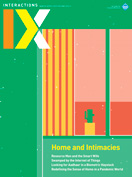Authors:
Daniela Rosner, Alex Taylor, Mikael Wiberg
Designing for home life is about designing for relationships. It's about intervening in the connections that shape how we reside, how we learn, and how we belong. Regardless of whether we live alone or with others, whether we feel connected or isolated, digital systems extend our homes to reflect and shape relationships. Shared calendaring applications, streaming media, family subscription services, smart speakers, home security systems—not so long ago these symbols of high-tech living became a mundane part of life, not just offering convenience but also conditioning those spaces with whom we share access and how we do so.
What kinds of relationships do our designs acknowledge? How do they make assumptions about whom and how we live, learn, or love? How might our homes reimagine our digital settings with more flexibility and care? And how should technologies for our homes be configured to feel private and secure, yet still open and welcoming? How do we temper the increased prevalence of surveillance in our private spaces, while introducing new services and devices that make our homes easier to access, use, maintain, and dwell in?
The home is a complex site for technology design and deployment—it is a space for privacy, intimacy, and closeness, as well as a social space we share with close friends. For many, it is also a place where they can grow up, and this sense of belonging is linked to the memories they make, the meals they share with friends and family, and, last but not least, to the place where people repeat their most basic daily routines, from getting up in the morning and getting ready for the day to finding shelter when it is time to rest. From this viewpoint, home is not only a place where we shift between private and social but also where we shift in energy levels, from the place where we celebrate birthdays and holidays to the place where we should be able to rest, relax, and disconnect from the world around us.
Alongside this perspective of home as a place in which we live and connect, and where technology now proliferates, we must also consider the home in affective terms, in terms of how we feel at home. Here, the home sets inside from out. As much as it is a physical space, it is a sensation or atmosphere that differentiates what we invest and believe in—the sacred—from all that is out there, precarious, unsafe, dangerous—profane, even. The sensation or feeling at home creates the conditions for security and belonging, and because of this the possibility to both experiment with and extend ourselves. Home is then a potentiality; in feeling at home there is the potential to ask questions about who we are and how else we might want to live. This poses questions around not just what we want to design but how we want to design. What have we become inured to in feeling at home? Amid the security that comes with belonging, can we ask how else we might want to think, want to feel?
The current issue probes these questions at the seams of life at home. With David Chatting's work, for example, we move from an unmaking that unravels the now-banal and taken-for-granted router to reflections on the historical precedents in domestic innovation and their comparisons with today. Linnea Öhlund situates our thinking on home in the immediate present, bringing together the unlikely bedfellows of isolation in the pandemic and humor to ask how technology plays into the possibilities of extending ourselves beyond the boundaries of home. And Yolande Strengers looks forward in work that questions the norms embedded in our domestic imaginaries, examining in particular the gendered stereotypes that shape sustainable domestic futures.
On a separate thread of thinking about home, Hafeni Mthoko and colleagues provoke questions about a wider notion of home within HCI and design, seeking to find a curriculum and methodology unique to African HCI. They question orientations centered in the Global North and explore a space for other ideas of home for HCI and design practice. Anicia Peters and Daniela Rosner separately dialogue with this proposal through their reflections on how case studies and other methodological enhancements can expand and complicate design beyond a Western gaze.
Together, these contributions engage a variety of relationships to technology and one another, revealing the intimacies our design practices have only begun to see and imagine.
Daniela Rosner, Alex Taylor, Mikael Wiberg
[email protected]
Copyright held by authors
The Digital Library is published by the Association for Computing Machinery. Copyright © 2023 ACM, Inc.








Post Comment
No Comments Found